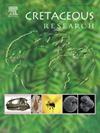基于最完整骨架的英国底龟lata Plastremys (Helochelydridae)解剖学、古地理和地层分布的新资料(西班牙Albian下游)
IF 1.9
3区 地球科学
Q1 GEOLOGY
引用次数: 0
摘要
在西班牙Ariño市(特鲁埃尔省)首次报道了两种helochelydrids的同步和同域存在,在那里发现了欧洲记录中最完整的该群体骨骼。这种基龟谱系的两个成员的存在在世界上很少的地方被记录下来,直到现在还由孤立和碎片化的遗骸组成。虽然低级Albian Aragochersis lignitesta仅在西班牙古生物学区域被记录在案,但来自Ariño的新材料被确定为英国Plastremys lata最古老的发现,扩大了该分类单元的古生物地理分布范围。新发现的化石包括部分骨架,以及几个个体的孤立遗骸。他们的分析不仅显示了种内变异性,而且还记录了一些以前不知道的lata Plastremys的解剖学元素,这些元素只从贝壳遗骸中知道。此外,研究了西班牙记录中定义的第一个中生代海龟分类群的地位(即迄今为止有问题的“Trachyaspis turbulensis”,也来自Teruel的下Albian),并对其完整型(其原始解剖归属在这里进行了修订)重新归属于Plastremys lata。本文章由计算机程序翻译,如有差异,请以英文原文为准。
New information on the anatomy and paleobiogeographic and stratigraphic distributions of the British basal turtle Plastremys lata (Helochelydridae) based on its most complete skeleton (lower Albian, Spain)
The synchronous and sympatric presence of two helochelydrids is reported here for the first time for the Spanish Municipality of Ariño (Teruel Province), where the most complete skeletons from that group had been found for the European record. The presence of two members of this lineage of basal turtles has been documented in very few localities worldwide, and until now consisted of isolated and fragmented remains. Although the lower Albian Aragochersis lignitesta is exclusively documented in this Spanish paleontological area, the new material from Ariño is identified as the oldest occurrence for the British Plastremys lata, extending the paleobiogeographic distribution range for that taxon. The new fossils include a partial skeleton, as well as isolated remains of several individuals. Their analysis not only shows intraspecific variability, but also documents several anatomical elements previously unknown for Plastremys lata, which was only known from shell remains. Furthermore, the status of the first Mesozoic turtle taxon defined for the Spanish record (i.e., the hitherto problematic ‘Trachyaspis turbulensis’, also from the lower Albian of Teruel) is examined and its holotype, whose original anatomical attribution is here revised, is reattributed to Plastremys lata.
求助全文
通过发布文献求助,成功后即可免费获取论文全文。
去求助
来源期刊

Cretaceous Research
地学-地质学
CiteScore
4.10
自引率
19.00%
发文量
235
审稿时长
12 weeks
期刊介绍:
Cretaceous Research provides a forum for the rapid publication of research on all aspects of the Cretaceous Period, including its boundaries with the Jurassic and Palaeogene. Authoritative papers reporting detailed investigations of Cretaceous stratigraphy and palaeontology, studies of regional geology, and reviews of recently published books are complemented by short communications of significant new findings.
Papers submitted to Cretaceous Research should place the research in a broad context, with emphasis placed towards our better understanding of the Cretaceous, that are therefore of interest to the diverse, international readership of the journal. Full length papers that focus solely on a local theme or area will not be accepted for publication; authors of short communications are encouraged to discuss how their findings are of relevance to the Cretaceous on a broad scale.
Research Areas include:
• Regional geology
• Stratigraphy and palaeontology
• Palaeobiology
• Palaeobiogeography
• Palaeoceanography
• Palaeoclimatology
• Evolutionary Palaeoecology
• Geochronology
• Global events.
 求助内容:
求助内容: 应助结果提醒方式:
应助结果提醒方式:


